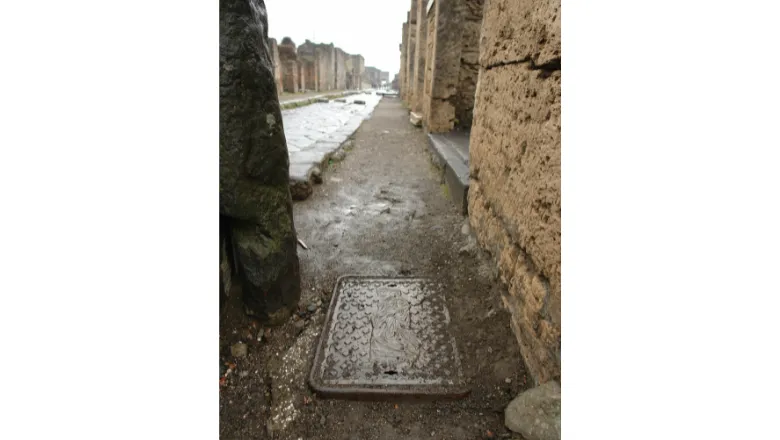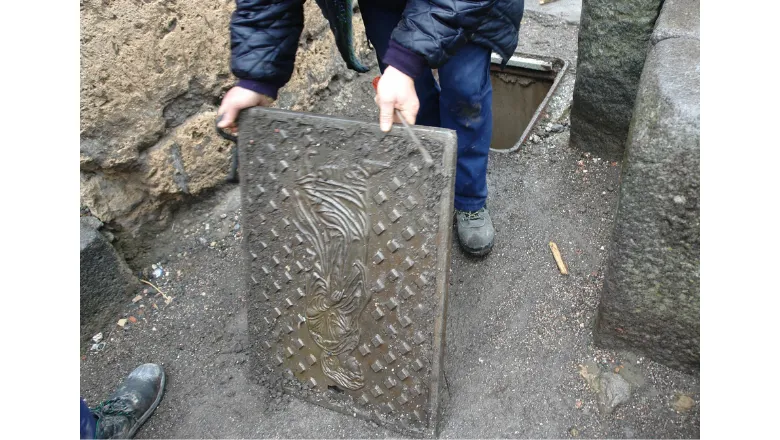William Cobbing

William Cobbing Gradiva Project 2007 Pompeii
William Cobbing studied sculpture at Central St Martins, De Ateliers, an artists’ institute in Amsterdam and a PhD at Middlesex University. Starting from a sculptural sensibility, Cobbing’s art practice encompasses a diverse range of media, including video and installation. Performative encounters are devised with material, such as clay, in which the protagonists are engaged in a repetitive and absurd cycle of manipulating formless surfaces. The works allude to concepts of entropy, underlining the extent to which earthly material is irreversibly dispersed, giving rise to a definitive blurring of the boundaries between the body and landscape, whilst putting the possibility of conclusion on hold.
Pasts to Come features two manhole covers by Cobbing that are copies of originals installed at the Freud Museum and Camden Arts Centre respectively. The iconography of both reference a visceral fascination with myth and archaeology from the first half of the twentieth century.
Gradiva Project, 2006-7, William Cobbing cast iron man hole cover
In Wilhelm Jensen’s novel Gradiva (1902) a young archaeologist falls in love with a woman – Gradiva, “she who walks beautifully” – depicted in a Roman bas relief and who, he is convinced, perished at Pompeii during the eruption of Vesuvius in 79 AD. Sigmund Freud, who claimed that the work of psychoanalysis and archaeology was “in fact identical”, was particularly delighted by the novel’s solution, in which the lovelorn archaeologists is cured through conversation with his long-lost childhood crush, who converts his desire for an ancient artefact into ‘normal’ sexual attraction. Freud hung a cast of the relief in his office.
In the late nineteenth and early twentieth century, antiquity became a touchstone for exploring sexual desires and pathologies. It is worth recalling that Jensen’s Gradiva was published the same year as André Gide’s L’immoraliste. another novel about a scholar exploring his sexuality during visits to ancient sites, but which explores homosexual desires and culminates in death rather than married Viennese bliss.
Cobbing’s manhole cover (a sister version is permanently installed outside the Freud Museum, London) is a gateway to the subterrain of civilisation. As an artwork based on Freud’s cast, inspired by Jensen’s novel, framed around a cast of an ancient artefacts, it is also part of a vertigo-inducing chain of projection, mimicry, and desire.
Acéphale, 2007, William Cobbing, Jesmonite cast of manhole cover
The image of the acéphale man (from the Greek “headless”) was designed by André Masson for the para-academic society and review with the same name, initiated by George Bataille in Paris during the Second World War. This loose-knit group of French leftist intellectuals responded to fascism by placing themselves on its level, which for Bataille meant “on the mythological plane”. The group explored Nietzsche, anthropology, and the irrational. Their efforts culminated in plans of a human sacrifice, for which several members volunteered to be the victim, but no one the executioner.
Cobbing’s manhole cover is permanently installed at the Camden Arts Centre, a short walk from the Gradiva cover at the Freud Museum. Between them, the two covers reference the fascination with the wild and unruly side of human culture and psyche shared by psychoanalysts and surrealist artists. Acéphale and Gradiva represents two related attempts to control and harness humanity’s most primitive drives and impulses.

William Cobbing, 2007, Acéphale

William Cobbing, 2006-7, Gradiva Project Install
